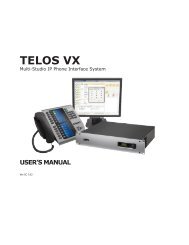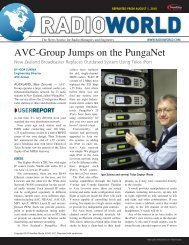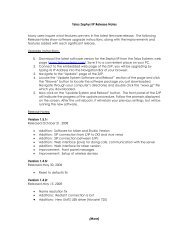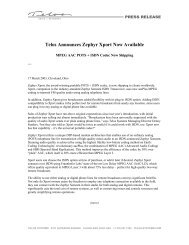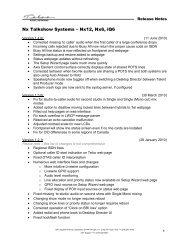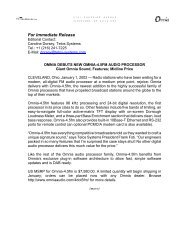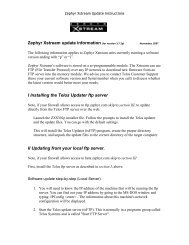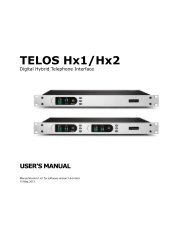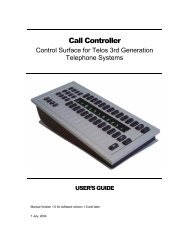NOW! 12-13 - Telos
NOW! 12-13 - Telos
NOW! 12-13 - Telos
Create successful ePaper yourself
Turn your PDF publications into a flip-book with our unique Google optimized e-Paper software.
LINEAR ACOUSTIC | LOUDNESS MANAGERS | TECHNOLOGY ARTICLE<br />
114<br />
LOUDNESS<br />
THE LISTEN TEST<br />
Audio loudness processing is becoming an increasingly important<br />
part of the broadcaster’s job as regulatory imperatives<br />
and sophisticated listeners demand more consistent audio levels.<br />
Not doing so can risk ines from regulatory agencies and<br />
drive viewers to competing providers that have their audio<br />
under control.<br />
There are many options when purchasing audio processors<br />
from manufacturers worldwide. Any broadcaster that is about<br />
to put out their hard-earned money for a processor needs to<br />
understand the differences between competing techniques<br />
and claims, and most importantly how to evaluate equipment<br />
from different manufacturers.<br />
A logical place to start is with an understanding of loudness<br />
measurement techniques and (where applicable) the regulations<br />
that reference them. The ITU-R BS.1770 measurement<br />
standard is the basis for loudness regulation in the US and Europe,<br />
as well as other technical regulations. One point of confusion<br />
about this standard is that some processing manufacturers<br />
claim they are “BS.1770” compliant, even though BS.1770 is a<br />
measurement, and not a processing, standard.<br />
One of the key points of BS.1770 is that loudness is a quantity<br />
that is integrated over a certain time period. While shorter integration<br />
times can be used, it is valid to measure entire programs<br />
(with an ininite integration time that is reset between<br />
programs). Unlike PPM and VU level meters, instantaneous<br />
loudness measurements have little utility.<br />
This is done for a straightforward reason: audio has dynamics.<br />
Digital audio broadcasts provide a much wider usable dynamic<br />
range than did analogue transmission standards. The average<br />
loudness level of audio content can be measured over time using<br />
a BS.1770 while still preserving this dynamic range.<br />
Some broadcasters who have evaluated loudness processors<br />
are surprised to see the output loudness level moving. They are<br />
especially sensitive when there are imperatives that give target<br />
loudness levels. Yet these target loudness levels are speciied<br />
over an entire program or even an entire broadcast day for a TV<br />
station. Within any normal program there are going to be varia-<br />
tions around the target loudness level. This is to be expected,<br />
since the long term or average loudness is what is important.<br />
The type of program content currently being processed will<br />
greatly affect dynamic range as well. Certain types of content -<br />
for example, some sports with constant crowd noise and near-<br />
constant play-by-play announcers - has relatively constant lev-<br />
els. Other types of content, such as classical music has wildly<br />
varying dynamics. Program producers edit their program audio<br />
with louder and softer portions for dramatic effect. These same<br />
producers will often object if the peak to average ratio of their<br />
programs is drastically altered during broadcast. Listeners with<br />
higher-end audio reproduction systems will also notice more<br />
limited dynamics.<br />
So what is best when processing such varying types of con-<br />
tent? As a general rule, preserving dynamics is beneicial. Using<br />
loudness processors with a range of preset conditions greatly<br />
simpliies set up for the broadcaster. Linear Acoustic Audio<br />
Loudness Managers have a range of presets that allow adjust-<br />
ment of all processing parameters. Included in this list are pre-<br />
sets that minimally alter the peak-to-average ratio of content<br />
while still achieving target average loudness values. Of course<br />
there are also “denser” presets that have considerably lower<br />
peak-to-average ratio.<br />
Both of these (and all of the other processing presets) will pro-<br />
duce audio with long term loudness at the target level. Many




